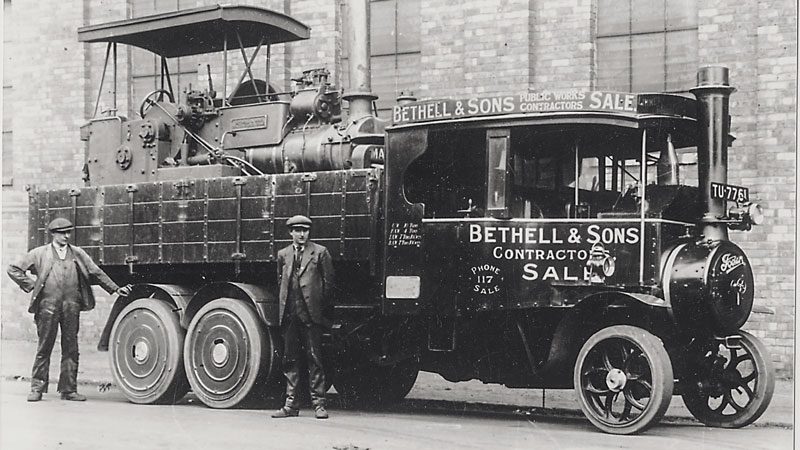
For more than 110 years, British Foden was well known for hauling heavy loads reliably around the British Empire, on the European continent, and in some other overseas markets.
British Foden founder Edwin Foden was born in 1841 in Sandbach, Cheshire, at a time when steam traction became increasingly important, especially in the field of agricultural machines.
In 1870, Foden gained control over the mechanisation company Hancock. Ten years later, Foden expanded to build steam-powered road locomotives, and 16 years later, the first steam truck. The first Overtype model, with a horizontal engine, appeared in 1901. At the time, the company was considered among the best manufacturers of steam- powered tractors and trucks.
Edwin Foden died in 1911. Although steam-powered vehicles were constantly improved after World War I, it was clear that combustion engines were the future. In 1929, Foden introduced its first diesel truck, developed in association with well-known engine manufacturer Gardner. During the 1930s, new models appeared for weights up to 15 ton. The DG range at the time also included the peculiar Chinese Six and four-axle twin- steer rigids.
During World War II, a prototype with a two-stroke diesel engine was built. But the Gardner 6LW remained the preferred power unit. Two years after the war, Foden built the first heavy dump truck. It was based on the DG model and had 6×4 drive and super single tyres. The rock body was also constructed by Foden. It was the beginning of a complete range of heavy dumpers, some also equipped with one-man cabs. The trucks had a load capacity of 15 ton, and became popular in export markets.
After the war, many hauliers on the continent were forced to run ex-army equipment. But in 1950, new Fodens started to appear on European roads, albeit in limited quantities. In The Netherlands, however, the sturdy British offerings from Sandbach made quite large inroads into the truck market. Sales went so well that, in 1952, Foden decided to start an assembly operation there under the name of Fodenway. In those days, the building industry needed a lot of stones to erect new houses. The legendary Foden FG6 and FG8 rigid trucks with drawbar trailers were just the thing local hauliers needed.
Compared with other European countries, the Dutch had very liberal maximum weight regulations. In the 1950s, and in fact still today, truck combinations of up to 50- and 60-ton GCW are allowed. The only problem in the 1950s was that the Fodens, with their 150hp (111kW) Gardner diesels, were not really up to operating at such high weights.
At about the same time, the British trucks became popular overseas – notably in Australia and New Zealand, but also in South Africa, Argentina, India and the Middle East. Chassis often received a locally assembled steel or fibreglass cab to cater for the different transport requirements in overseas markets. However, in the home market, starting from the 1970s, various fully assembled cab options made from steel, fibreglass (GRP), or a combination of both became available. There were also steel sleeper cabs fabricated by Motor Panels. A similar structure was also fitted to other British and foreign trucks, such as, for example, ERF, Guy and Scammell, plus Dutch FTF.
In the late 1970s and 1980s, Foden offered S10 tilt cabs made of a steel frame with GRP panels and aluminium parts. When Foden came under the wings of American company Paccar in 1980, the fibreglass S10 cab was still used. Then, in 1987, the 4000 Series forward- control truck with updated S106 cab was launched and was well received by operators. Unfortunately, exports had almost come to a halt, except for New Zealand, South Africa, and Switzerland, of all places.
In 1991, the well-known haulage operator Friderici bought 32 4000 Series trucks and some more in 1993-94. The American driveline and lightweight construction were the main reasons to invest in the British product. At the time, Switzerland only permitted a 28-ton gross combination weight on domestic roads.
The Foden Alpha, with its DAF-derived steel cab, debuted in 1998 but never made it to the continent. That was a pity as this new forward-control range – built at the former Leyland plant – really looked the part, especially in high- roof sleeper-cab form. Thanks to the influence of the United States owner, sales flourished in technical fields. Aluminium components were fitted more often, as were Caterpillar diesel engines and Eaton Twin Splitter transmissions.
Like the 4000-Series, the Alpha was available in 4×2, 6×4 and 8×4 chassis configurations. Although the 4000 was still popular in quite a few overseas markets, the new Alpha range only made it in some quantity to New Zealand, perhaps because Kiwi haulage operators had built up a long and solid relationship with the British manufacturer. Sales of traction engines and goods vehicles Down Under began well before World War II, but when Fodenway Motors was set up in 1952, imports to New Zealand really expanded. The 1960s and 1970s were the heyday of Foden sales here and in Australia.
Unfortunately, when the British manufacturer ran into financial problems, exports to many parts of the world almost stopped. But in the 1980s, thanks to a new importer and new models like the 4000 Series, and later, the Alpha, sales to New Zealand customers increased again. Unfortunately, all this activity, at home and abroad, was once more not enough for Foden to survive. To the disappointment of many Foden users and fans, the American owner decided in 2005 to permanently withdraw the old British name from the market.
Read more
From our travels
0 Comments1 Minute
Maximum nostalgia
0 Comments5 Minutes
Meeting Volvo’s VNL
0 Comments13 Minutes
A yank with a Dutch touch
0 Comments8 Minutes



















